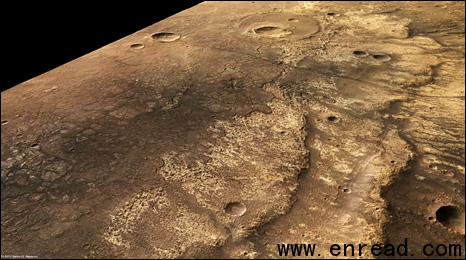| ||||||||||||||||||||||||||||||||||||||||||||||||||||||||||||||||||||||||||||||||||||||||||||||||
|
Methane1 on Mars is produced and destroyed far faster than on Earth, according to analysis of recent data. 最近的统计数据显示,火星上的甲烷产生和消亡比地球上的快多了。  The Martian surface is very hostile to organics say scientists Scientists in Paris used a computer climate model for the Red Planet to simulate observations made from Earth. It shows the gas is unevenly3(不平坦地,不均衡地) distributed in the Martian atmosphere and changes with the seasons. The presence of methane(甲烷) on Mars is intriguing4(吸引人的,有趣的) because its origin could either be life or geological activity - including volcanism. Writing in the journal Nature, Franck Lefevre and Francois Forget from the Universite Pierre et Marie Curie in Paris describe how they used a computer model of the Martian climate to reconstruct observations made by a US team. Dr Lefevre says the chemistry of the Martian atmosphere is still a mystery. He told BBC News: "We put the dynamics5(动力学) and chemistry as we know it in the model and tried to match the measurements, to reproduce the uneven2 distribution they saw from Earth." "The problem is if we just take into account the photochemistry(光化学) as we know it on Earth and if we put it in the model, then we cannot reproduce the model and that was a surprise." "The current chemistry as we know it is not consistent with the measurements of methane on Mars." "There is something else going on, something that lowers the methane lifetime by a factor of 600. So if the measurements are correct, we must be missing something quite important." Dr Lefevre says the work shows that if there is a much faster loss for methane on Mars there must also be a much stronger production of methane. But he urges caution: "It's a real challenge to measure methane on Mars from Earth and we've got only one example of this uneven distribution." The results the French team used were published in January this year in the journal Science. They were gathered by an American team using a technique called infrared6 spectroscopy(红外光谱学) at three different ground-based telescopes to monitor about 90% of the planet's surface. In 2003 "plumes8" of methane were identified. At one point, the primary plume7 of methane contained an estimated 19,000 tonnes of the gas. Dr Michael Mumma, director of Nasa's Goddard Center for Astrobiology and lead author on the previous paper, told BBC News it was vital to understand how methane was destroyed on Mars and to explain how so much of the gas is produced and destroyed so quickly on the Red Planet. Dr Mumma does not rule out a biological explanation for the phenomenon but says it is possible that geology alone could be responsible. If the methane is produced by geological activity, it could either originate from active Martian volcanoes or from a process called serpentinisation. The latter process occurs at low temperatures when rocks rich in the minerals olivine(橄榄石) and pyroxene(辉石) react chemically with water, releasing methane. In December, Dr Mumma's team will begin another study of the Martian surface using the new technique of adaptive optics(自适应光学) at the European Southern Observatory's Very Large Telescope (VLT) in Chile. They hope to replicate9(折叠,复写) their earlier results. Dr Lefevre says that if the variations are confirmed it would mean the Martian surface is very hostile for organics. But this would not necessarily exclude the possibility that life or the remnants(剩余,残余) of past life persist below ground, where conditions could be more benign10. Nasa is due to launch a $2.3bn nuclear-powered rover(漂流者,流浪者) known as Mars Science Laboratory (also called "Curiosity") to the planet in 2011. Under one possible scenario11, the European and US space agencies would then send a European orbiter to the Red Planet in 2016 to track down the sources of methane. A subsequent 2018 launch opportunity would be taken by the European ExoMars rover, launching on a US Atlas12 rocket. The proposal currently being discussed is that ExoMars should be joined by a slightly smaller rover in the class of the US Spirit and Opportunity vehicles that are on the surface today. ExoMars and its smaller cousin could be targeted at the Methane sources identified by the 2016 orbiter. 点击  收听单词发音 收听单词发音
|
||||||||||||||||||||||||||||||||||||||||||||||||||||||||||||||||||||||||||||||||||||||||||||||||
- 发表评论
-
- 最新评论 进入详细评论页>>



